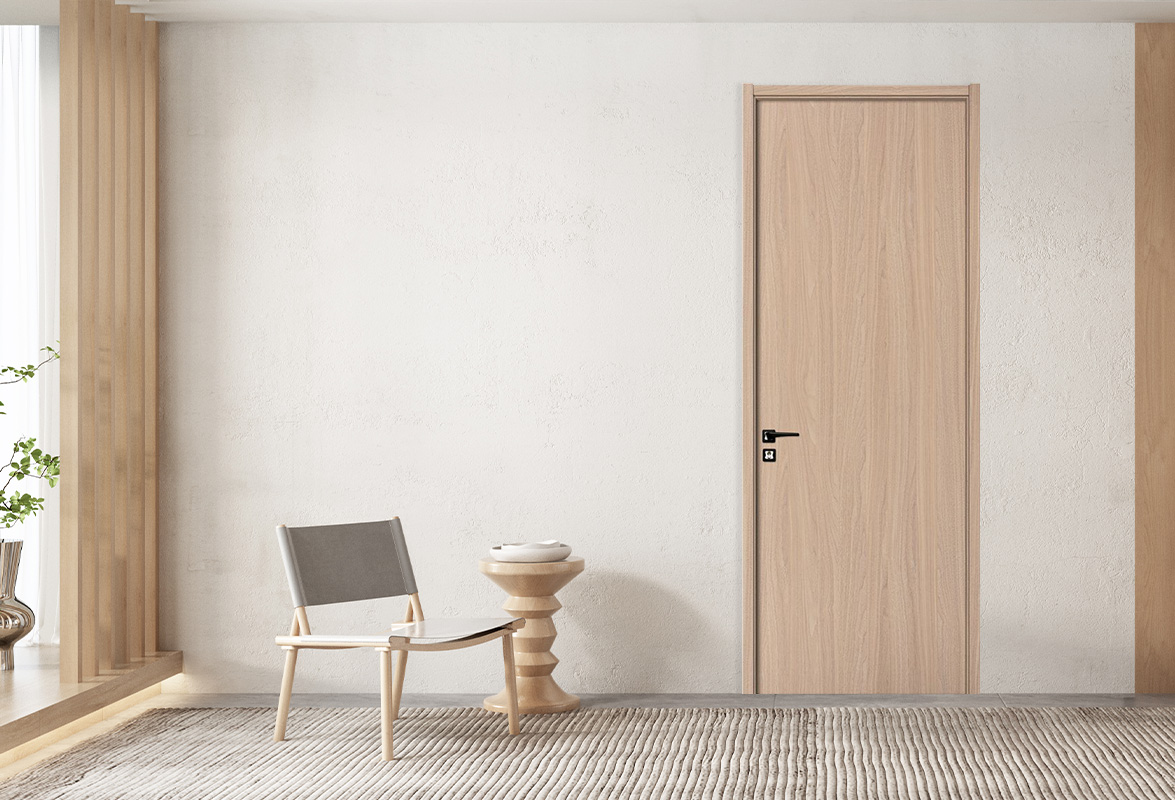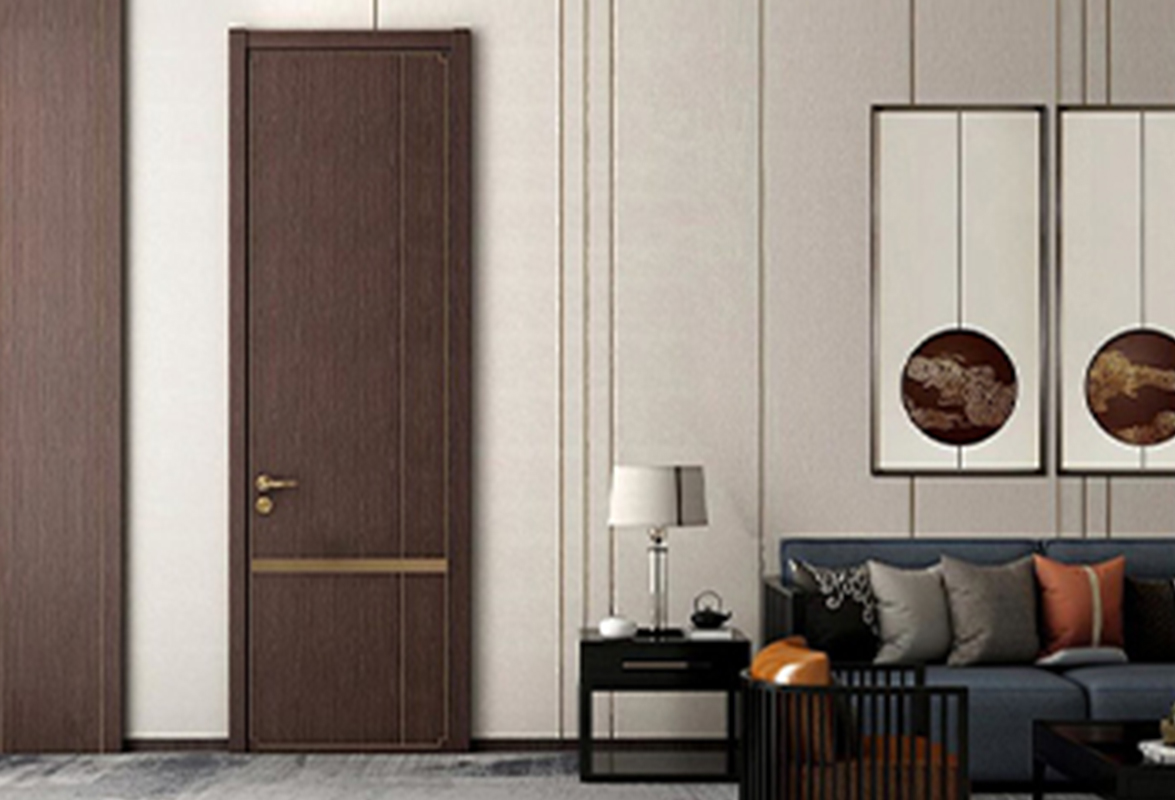Now, doors are no longer mere separators between rooms. They have evolved into essential components that influence spatial perception, light reflection, and acoustic balance. The presence of moisture in certain environments presents a unique challenge, and it is in response to this that HPL Door Factory has focused on producing doors that maintain stability without compromising aesthetics. Laminated panels combine multiple layers of resin-impregnated fibers compressed under high pressure, creating structures that resist moisture infiltration. This approach transforms a simple door into a functional component capable of enduring environmental stress while maintaining a refined surface appearance.
The intelligence of material design extends beyond surface treatment. Each layer within the laminated panel serves a distinct purpose. The core provides structural integrity, minimizing expansion when humidity rises. Intermediate layers distribute stress evenly, preventing localized distortion. The decorative surface resists stains, abrasions, and minor impacts. This orchestration of components ensures the door maintains alignment with frames and hardware even under continuous exposure to water vapor.
HPL Door Performance Against Moisture
Moisture presents a complex problem in interior construction. Vapor permeates, condenses, and reacts with materials, gradually altering mechanical and aesthetic properties. The development of high-pressure laminated doors addresses these challenges by combining precision engineering with material science. HPL doors undergo a compression process that consolidates layers into a cohesive unit, reducing the potential for warping or delamination. Edge sealing further prevents the intrusion of moisture at points where panels meet frames or hardware.
Beyond structural integrity, laminated doors offer predictability in behavior. Temperature fluctuations often accompany humidity changes. Materials expand and contract differently under varying conditions. By carefully selecting core materials and bonding agents, manufacturers achieve a product that responds uniformly to environmental stress, avoiding the uneven deformations common in traditional doors. Consistent performance ensures that hinges remain aligned, closures remain tight, and the tactile feel of the surface remains unchanged over time.
The Rise of Bathroom as Living Space
Bathrooms have evolved from purely utilitarian areas into spaces that reflect lifestyle and design preference. They are no longer hidden behind closed doors; they form part of a home’s narrative. Interiors now prioritize light diffusion, color continuity, and visual balance. In this context, the choice of door material becomes critical. The door must harmonize with finishes, complement the arrangement of fixtures, and withstand environmental factors unique to these areas.
HPL doors meet these demands by offering resilience without sacrificing aesthetics. Their capacity to resist moisture enables designers to maintain consistent finishes throughout the home. A door in a wet environment retains its shape and texture, allowing the space to integrate seamlessly with surrounding rooms. This continuity contributes to the perception of flow, enhancing both practical function and visual coherence.
Key advantages of HPL doors in bathroom environments include:
-
Resistance to warping or swelling under high humidity
-
Consistent surface texture and tactile quality
-
Compatibility with surrounding finishes and fixtures
-
Minimal maintenance requirements
-
Long-term durability in moisture-prone areas
Keeping Your Home Feeling Smooth and Cozy
One of the hallmarks of modern interiors is cohesive design. Surfaces, textures, and tones transition smoothly from one space to another, creating a home that feels thoughtfully arranged rather than patched together. HPL doors help achieve this goal by maintaining consistent finishes across rooms with different environmental conditions. Whether it’s a wood-like texture in the living room, a stone pattern in a hallway, or a subtle matte finish in a bathroom, these doors retain their appearance and feel, resisting moisture, fading, or surface irregularities.
The sensory experience of touch plays a big role in how a home feels. When a door opens smoothly, closes without sticking, and has a surface that feels solid and even under your hand, it conveys reliability and comfort. Even minor things, like the cool, smooth surface of a door handle or the way a door swings without creaking, contribute to the everyday sense of ease. Homeowners are increasingly noticing these details, linking material consistency and smooth operation to a feeling of quality and care in their living space.

Beyond aesthetics and touch, HPL doors contribute to a calm, organized atmosphere. Imagine walking from a humid bathroom into a bedroom and feeling no visual or tactile interruption. The consistent look and reliable performance of these doors help rooms blend seamlessly, supporting a flow that makes a home feel cozy, cared-for, and comfortable. Choosing doors that perform well under varying conditions isn’t just about durability—it’s about ensuring every interaction with your home feels smooth, effortless, and pleasant.
Craftsmanship and Sustainability
The manufacturing of laminated doors integrates precision machinery with skilled labor. Layers are aligned and pressed to exact tolerances, edges are sealed, and surfaces are polished to uniformity. Quality control involves repeated inspections to confirm density, bonding integrity, and resistance to moisture cycles. This attention to detail ensures the longevity of the product, reducing the need for replacements and minimizing waste.
Sustainability intersects with durability in meaningful ways. Materials that endure humidity for years lessen the demand for resource-intensive replacements. The production processes for laminated panels increasingly emphasize energy efficiency and responsible use of raw materials. By extending the life cycle of each door, manufacturers contribute to a reduction in material consumption while maintaining performance standards.
Living Experience and Emotional Design
The presence of a well-made door in a humid environment has subtle yet profound effects on everyday life. Quiet operation, consistent texture, and predictable fit enhance routine interactions. A door that resists swelling allows hinges to function smoothly, minimizing creaks or resistance. The tactile quality of the surface, unaffected by condensation, fosters a sense of stability. These small details collectively improve the user’s perception of space, contributing to psychological comfort and satisfaction.
Key aspects that HPL doors bring to everyday living
-
Smooth and quiet operation that enhances user comfort
-
Resistance to swelling and warping in humid conditions
-
Consistent surface texture for a reliable tactile experience
-
Enhanced alignment and performance of hinges and hardware
-
Contribution to psychological comfort through visual and sensory stability
Interior designers increasingly consider emotional response as part of material selection. Spaces that feel cohesive, resilient, and tactilely pleasing positively influence mood and well-being. By combining engineering and aesthetic sensibility, HPL doors create environments where form, function, and feeling coexist.
Integration with Modern Construction
Doors in humid areas do not exist in isolation—they are part of a complex interior ecosystem. Their interaction with frames, hardware, and surrounding finishes defines both performance and longevity. HPL doors are engineered to integrate seamlessly with contemporary construction practices, ensuring that daily use does not compromise structural integrity or aesthetics.
-
Frame Compatibility: Slight expansions due to humidity are absorbed without compromising seal alignment or hinge operation.
-
Hardware Stability: Locks, handles, and hinges maintain alignment over time, preventing sticking or uneven gaps.
-
Surface Durability: Laminated panels resist scratches and abrasions from frequent contact, including accidental knocks from cleaning tools or furniture.
-
Chemical Resistance: Common bathroom cleaners, soaps, and detergents have minimal impact on surface finish, maintaining the intended color and texture.
Imagine a busy morning where multiple family members move between bathroom, hallway, and bedroom. A traditional wooden door might swell, creak, or stick, forcing extra care during use. In contrast, HPL doors glide smoothly, maintaining their original alignment and tactile consistency. This harmony supports the home’s functionality, reduces stress, and ensures that construction standards are respected even after years of use.
Innovation in Layering and Core Composition
Modern HPL doors are more than decorative panels—they are the result of sophisticated engineering designed to resist environmental stress. At the heart of each door lies a core constructed from high-density fibers, reinforced with resins that enhance rigidity and moisture resistance. Intermediate layers act as buffers, distributing stresses caused by condensation or vapor, while decorative overlays provide aesthetic flexibility.
-
Layered Protection: Core layers absorb expansion forces, reducing the risk of warping or delamination.
-
Moisture Barrier: Overlays and surface finishes create an additional shield, preventing water penetration.
-
Edge Treatments: Seals and laminated wraps protect the vulnerable edges where panels meet frames.
-
Bonding Excellence: Advanced adhesives and thermal curing techniques keep layers unified even under continuous exposure to steam or humidity.
Consider a bathroom that experiences daily steam from showers. Each HPL door functions as a miniature climate-controlled system, maintaining its structural and visual integrity. Homeowners do not need to worry about warping, peeling, or discoloration, even in spaces where humidity fluctuates dramatically throughout the day. The innovation lies not only in materials but in the way each layer interacts with the next, producing a door that anticipates environmental challenges rather than succumbing to them.
Maintenance and Longevity
One of the great practical advantages of HPL doors is their low-maintenance nature. Surfaces remain smooth and visually consistent with minimal effort, while cores and edges retain stability even after years of exposure to moisture.
-
Cleaning Simplicity: Gentle cleaning agents and soft cloths suffice; no harsh chemicals or sanding are needed.
-
Core Stability: The consistent density prevents warping or bending, maintaining reliable operation over time.
-
Seal Durability: Edges and seals retain their protective function, preventing water ingress and reducing risk of mold or damage.
-
Operational Predictability: Hinges, locks, and panels continue to perform smoothly, reducing the need for adjustments or repairs.
Daily scenarios illustrate the benefits: a family finishes a shower, and the door swings shut quietly; no sticky surfaces, no misaligned locks, and no marks from water or cleaning. Over months and years, these qualities reduce homeowner stress, avoid unexpected maintenance, and contribute to a more efficient household. HPL doors support long-term lifestyle planning, allowing residents to focus on living rather than constant upkeep.
Future Outlook in Interior Material Design
As interiors evolve, the demand for materials that combine resilience, aesthetic flexibility, and sustainability will continue to grow. Doors must no longer be treated as secondary elements but as integral components of living spaces. HPL doors demonstrate how thoughtful design, engineering, and production can meet these expectations.
Manufacturers are exploring even more efficient laminating methods, environmentally friendly bonding agents, and modular designs that simplify installation. Consumer awareness about longevity, environmental responsibility, and daily usability shapes the direction of innovation. The intersection of these factors points toward a future where interior elements like doors contribute actively to comfort, cohesion, and ecological mindfulness.
The combination of aesthetic stability, resistance to moisture, and careful craftsmanship positions laminated doors as key contributors to modern living environments. Homes equipped with these products benefit from consistent finishes, tactile satisfaction, and minimized maintenance, all while supporting sustainable practices in material production.
Sensory Experience and Daily Interaction
The interaction between humans and their surroundings often goes unnoticed, yet doors play a subtle role in shaping perception. Opening a door should feel smooth and responsive; closing it should convey security without exertion. In environments with high humidity, traditional doors often compromise these experiences. Swelling, warping, or sticking affects not only physical movement but also the psychological comfort of residents. HPL doors, with their engineered layers and stable cores, preserve consistency in touch and motion.
In bathrooms or areas with fluctuating moisture levels, these doors maintain a reliable tactile experience. The surface feels steady to the hand, hinges move without obstruction, and seals hold their integrity. Residents unconsciously register these qualities, interpreting them as an indication of care in material selection and craftsmanship. Such interactions, subtle as they are, contribute significantly to the sense of order and satisfaction within a home.
| Design & Function Aspect | HPL Door Benefit | Practical Impact | Aesthetic/Emotional Effect |
|---|---|---|---|
| Visual Continuity | Patterned surfaces, natural textures maintain consistency | Aligns doors with interior décor | Supports a cohesive visual narrative, enhances perception of space |
| Structural Resilience | Laminated panels resist warping, swelling, and delamination | Ensures long-term performance in humid or wet areas | Reduces maintenance, provides tactile satisfaction |
| Transitional Spaces | Stable form in bathrooms connecting to living/bedroom areas | Avoids misalignment and gaps | Enhances flow and spatial integration |
| Light Reflection | Flat panels and controlled surface finishes | Prevents irregular shadows, reduces glare | Creates visually comfortable, balanced environments |
| Spatial Planning | Predictable size and shape under humidity changes | Allows precise layout and furniture arrangement | Supports intentional design, removes uncertainty from interior planning |
Resilience in Routine Life
Bathrooms, kitchens, and laundry areas are high-traffic zones with repeated exposure to moisture. Daily activities such as opening shower doors, accessing storage, or moving through corridors test the endurance of interior elements. HPL doors withstand these pressures with minimal maintenance. Their laminated composition absorbs minor impacts without chipping, and surface finishes resist staining from water, cleaning agents, or accidental spills.
This resilience reduces the need for frequent repairs or adjustments, saving time and resources for homeowners. Beyond convenience, it reflects a deeper design philosophy: interiors should accommodate life without compromising aesthetics or structural integrity.
Adaptation to Environmental Stress
Temperature and humidity fluctuate more in certain parts of a home. Traditional wood or composite doors often expand, contract, or warp unevenly, which can affect lock alignment and door operation. HPL doors respond predictably to environmental stress. By combining cores with specific densities and bonding techniques, they maintain uniform behavior even when external conditions change.
This predictability allows architects and interior designers to plan spaces with confidence. The doors can be specified for areas with extreme humidity differences without requiring special adjustments or protective measures. The material itself manages the environmental challenge, simplifying both installation and long-term usability.
Innovation in Materials and Manufacturing
Recent advancements in laminating processes have significantly enhanced door performance. Controlled pressure, temperature, and resin composition produce panels that are denser, more cohesive, and more resistant to moisture penetration. Edge treatments, including seals and wraps, prevent water ingress at points most vulnerable to damage.

Manufacturers now experiment with layering techniques that combine structural cores with decorative overlays, providing both strength and aesthetic flexibility. Surface finishes resist scratches, abrasion, and minor chemical exposure, preserving visual integrity. These innovations make HPL doors adaptable across multiple interior scenarios, including wet environments, high-traffic corridors, and areas with frequent temperature shifts.
Long-Term Sustainability and Environmental Considerations
Durability intersects with environmental responsibility. Doors that withstand high humidity without replacement contribute to reduced material waste. Laminated panels often incorporate recycled fibers and resins, lowering the environmental footprint of production. By extending service life, these products minimize resource consumption while maintaining quality and performance.
The emphasis on longevity also benefits homeowners. Investing in doors that sustain form and finish for years reduces ongoing costs, maintenance effort, and the environmental impact associated with replacement cycles. This alignment of performance and sustainability reflects a growing trend in responsible interior design.
Emotional and Psychological Influence
The subtle influence of doors on mood and perception should not be underestimated. Residents sense stability through touch, sight, and operational reliability. HPL doors, with their uniform surfaces and predictable mechanics, convey a sense of order and care. In wet areas, where traditional materials may show distortion or water marks, these panels maintain visual and tactile consistency, fostering reassurance.
Designers and psychologists note that environments offering reliable interaction and sensory satisfaction enhance overall well-being. A door that functions seamlessly under high humidity contributes to a perception of control and harmony within the home. The material thus performs both practical and emotional roles.
Harmonizing with Furniture and Fixtures
High-pressure laminated doors integrate well with modern fixtures, cabinetry, and hardware. Their stability ensures that hinges, locks, and handles maintain alignment over time, even in rooms where moisture exposure is high. Cabinet doors, wall panels, and furniture adjacent to these doors remain visually and functionally compatible.
This compatibility reduces installation challenges and ensures a coherent visual language throughout the space. Designers can coordinate textures, colors, and finishes without concern that humidity will compromise alignment or appearance.
Realizing Vision Through Craftsmanship
The creation of high-quality laminated doors requires meticulous attention at every stage. Layers must be precisely aligned, bonding agents uniformly applied, and surfaces finished to exacting standards. The craftsmanship ensures that doors meet rigorous expectations for resistance, performance, and aesthetic consistency.
Skilled production combined with careful material selection results in panels that maintain structural and visual integrity for years. Maintenance remains straightforward, environmental exposure is well managed, and users benefit from predictable interactions.
Through innovation in materials, engineering, and design, laminated doors provide a solution for environments historically challenging for traditional doors. The combination of moisture resistance, surface stability, and aesthetic flexibility ensures that HPL doors integrate seamlessly into modern interiors, particularly in areas with high humidity.
The enduring reliability and visual appeal of these products are now recognized by homeowners, designers, and architects alike. Their performance bridges the gap between practical necessity and emotional satisfaction, demonstrating that thoughtful material selection can elevate the everyday living experience.
At the forefront of this commitment, Zhejiang Haibo Door Co., Ltd. continues to advance production techniques, material innovation, and design sensibility. By combining engineering precision with aesthetic insight, the company delivers HPL doors that thrive in humid environments while contributing to durable, harmonious, and sustainable interior spaces.

 English
English русский
русский Français
Français Español
Español bahasa Indonesia
bahasa Indonesia عربى
عربى



